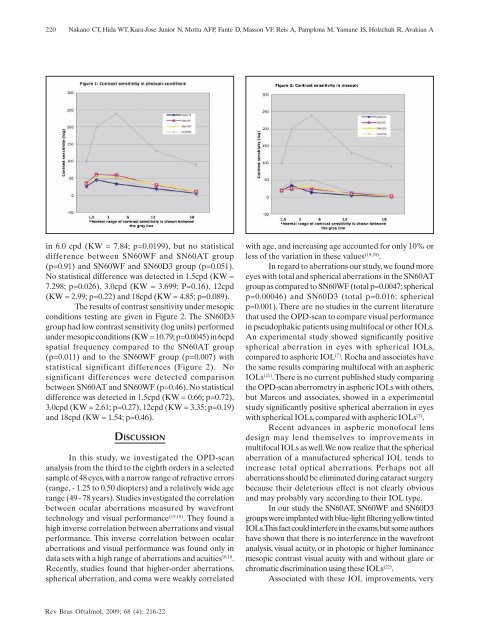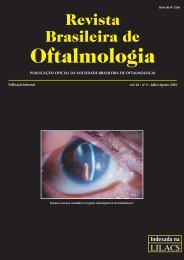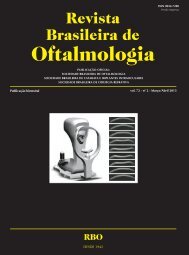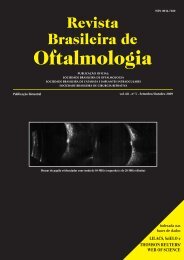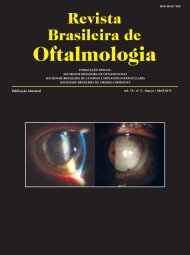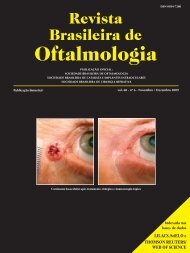Jul-Ago - Sociedade Brasileira de Oftalmologia
Jul-Ago - Sociedade Brasileira de Oftalmologia
Jul-Ago - Sociedade Brasileira de Oftalmologia
- No tags were found...
You also want an ePaper? Increase the reach of your titles
YUMPU automatically turns print PDFs into web optimized ePapers that Google loves.
220Nakano CT, Hida WT, Kara-Jose Junior N, Motta AFP, Fante D, Masson VF, Reis A, Pamplona M, Yamane IS, Holzchuh R, Avakian Ain 6.0 cpd (KW = 7.84; p=0.0199), but no statisticaldifference between SN60WF and SN60AT group(p=0.91) and SN60WF and SN60D3 group (p=0.051).No statistical difference was <strong>de</strong>tected in 1.5cpd (KW =7.298; p=0.026), 3.0cpd (KW = 3.699; P=0.16), 12cpd(KW = 2.99; p=0.22) and 18cpd (KW = 4.85; p=0.089).The results of contrast sensitivity un<strong>de</strong>r mesopicconditions testing are given in Figure 2. The SN60D3group had low contrast sensitivity (log units) performedun<strong>de</strong>r mesopic conditions (KW = 10.79; p=0.0045) in 6cpdspatial frequency compared to the SN60AT group(p=0.011) and to the SN60WF group (p=0.007) withstatistical significant differences (Figure 2). Nosignificant differences were <strong>de</strong>tected comparisonbetween SN60AT and SN60WF (p=0.46). No statisticaldifference was <strong>de</strong>tected in 1.5cpd (KW = 0.66; p=0.72),3.0cpd (KW = 2.61; p=0.27), 12cpd (KW = 3.35; p=0.19)and 18cpd (KW = 1.54; p=0.46).DISCUSSIONIn this study, we investigated the OPD-scananalysis from the third to the eighth or<strong>de</strong>rs in a selectedsample of 48 eyes, with a narrow range of refractive errors(range, - 1.25 to 0.50 diopters) and a relatively wi<strong>de</strong> agerange (49 - 78 years). Studies investigated the correlationbetween ocular aberrations measured by wavefronttechnology and visual performance (15,18) . They found ahigh inverse correlation between aberrations and visualperformance. This inverse correlation between ocularaberrations and visual performance was found only indata sets with a high range of aberrations and acuities 16,18 .Recently, studies found that higher-or<strong>de</strong>r aberrations,spherical aberration, and coma were weakly correlatedwith age, and increasing age accounted for only 10% orless of the variation in these values (19,20) .In regard to aberrations our study, we found moreeyes with total and spherical aberrations in the SN60ATgroup as compared to SN60WF (total p=0.0047; sphericalp=0.00046) and SN60D3 (total p=0.016; sphericalp=0.001). There are no studies in the current literaturethat used the OPD-scan to compare visual performancein pseudophakic patients using multifocal or other IOLs.An experimental study showed significantly positivespherical aberration in eyes with spherical IOLs,compared to aspheric IOL (7) . Rocha and associates havethe same results comparing multifocal with an asphericIOLs (21) . There is no current published study comparingthe OPD-scan aberrometry in aspheric IOLs with others,but Marcos and associates, showed in a experimentalstudy significantly positive spherical aberration in eyeswith spherical IOLs, compared with aspheric IOLs (7) .Recent advances in aspheric monofocal lens<strong>de</strong>sign may lend themselves to improvements inmultifocal IOLs as well. We now realize that the sphericalaberration of a manufactured spherical IOL tends toincrease total optical aberrations. Perhaps not allaberrations should be eliminated during cataract surgerybecause their <strong>de</strong>leterious effect is not clearly obviousand may probably vary according to their IOL type.In our study the SN60AT, SN60WF and SN60D3groups were implanted with blue-light filtering yellow tintedIOLs. This fact could interfere in the exams, but some authorshave shown that there is no interference in the wavefrontanalysis, visual acuity, or in photopic or higher luminancemesopic contrast visual acuity with and without glare orchromatic discrimination using these IOLs (22) .Associated with these IOL improvements, veryRev Bras Oftalmol. 2009; 68 (4): 216-22


